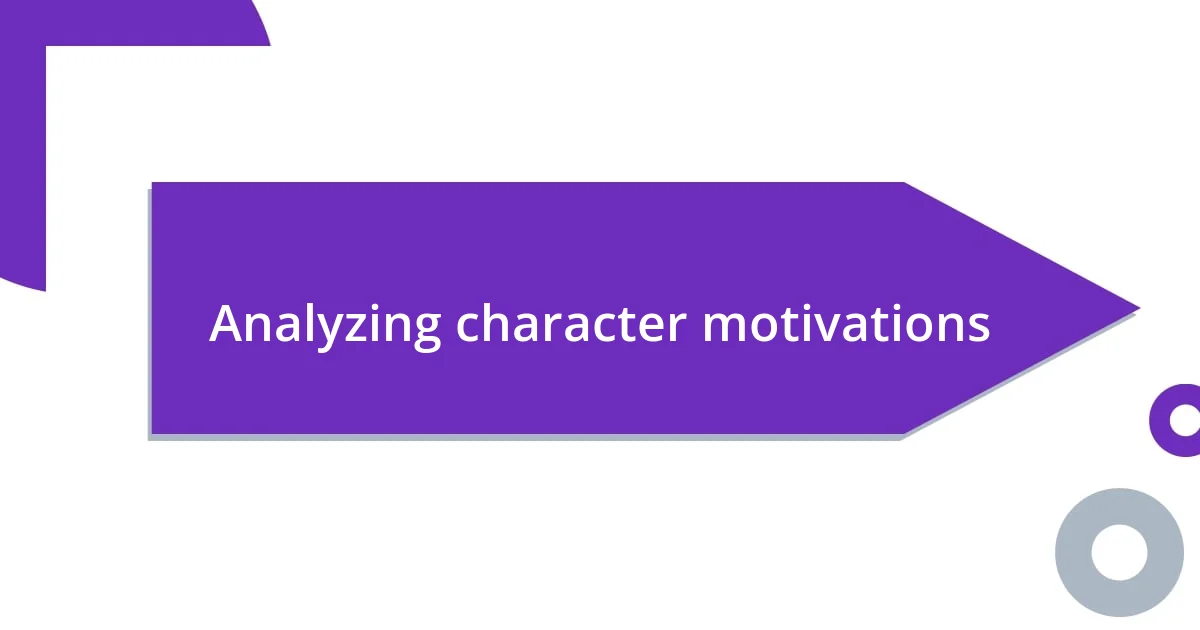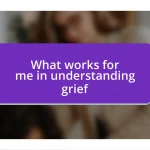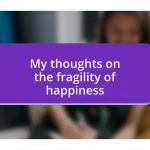Key takeaways:
- Moral dilemmas in storytelling reveal characters’ true natures and encourage readers to confront their values and biases.
- Analyzing character motivations adds depth to narratives, influencing plot development and reader investment.
- Resonant resolutions often explore gray areas of morality, prompting readers to reflect on their own beliefs and choices.

Understanding moral dilemmas in storytelling
Understanding moral dilemmas in storytelling invites me into the deeper layers of human experience. Think about a moment in a book or film when a character must choose between loyalty and justice. How did that decision resonate with you? I find that these dilemmas reveal not only the characters’ true natures but also spark critical reflections within myself and the audience.
When I reflect on my own storytelling experiences, a particular character stands out—a mother torn between saving her child or a group of strangers. It was a heart-wrenching choice, and I remember sitting at my desk, fully immersed in her anguish. I questioned how I would react in such a dire situation. Those moments of hesitation in my narratives have often led readers to confront their values and biases, making moral dilemmas an essential tool in creating a rich emotional landscape.
People often underestimate the impact of moral dilemmas in shaping narratives. They provide a unique opportunity to explore complex emotions and provoke discussions about right and wrong. I recall a workshop where we discussed the ‘greater good’ versus personal sacrifice, a theme that resonated deeply with all of us. It’s fascinating how grappling with these questions doesn’t just clarify a storyline but enhances its relatability and emotional depth, inviting readers to reflect on their choices.

Identifying common moral dilemmas
Identifying common moral dilemmas in storytelling can be incredibly enlightening. These situations often present characters with choices that challenge their moral compass, forcing them to weigh personal beliefs against societal expectations. I recall writing a scene where a character faced the decision to betray a friend for personal gain. As I explored their inner conflict, I felt a knot in my stomach, realizing how relatable such a choice is in real life.
Here are some frequent moral dilemmas I’ve encountered in storytelling:
- Loyalty vs. Truth: Choosing whether to protect a friend’s secret or reveal the truth that might cause harm.
- Self-Preservation vs. Sacrifice: Deciding whether to save oneself or risk everything to help others in danger.
- Justice vs. Forgiveness: Struggling between seeking retribution or offering mercy to a wrongdoer.
- Individual Needs vs. Collective Good: Balancing personal desires against the welfare of a larger community.
- Conformity vs. Authenticity: The tension between fitting in and being true to oneself, often leading to heart-wrenching choices.
As I explore these scenarios, I find that each dilemma reflects real emotional struggles, making the characters’ journeys resonate deeply with readers. It’s fascinating to see how these themes can draw us into the narrative, prompting us to think about what we might do in similar situations.

Analyzing character motivations
Analyzing a character’s motivations can truly enhance the storytelling experience. I often reflect on a story I wrote where a detective grapples with the need for justice while battling his own demons. His internal struggle was rooted in personal loss, which fueled his relentless pursuit of truth. As I developed him, I realized how crucial it was to allow readers to uncover his motivations gradually, creating an emotional bond that deepens their investment in the story.
Sometimes, I take a moment to dissect why characters make certain choices. A character seeking revenge can evoke empathy if we understand their backstory—perhaps a betrayal shaped their worldview. I remember crafting a villain who had once been a hero, driven to darkness after losing everything. That complexity highlighted the delicate interplay between purpose and emotion, reminding me that motivations, whether noble or flawed, shape the essence of characters in profound ways.
When I analyze character motivations, I ask myself: What drives them? What fears haunt them? Such questions add layers to the narrative. I think about a protagonist I wrote who constantly wrestled with self-doubt, making every decision a fierce battle. In doing this, I discovered that motivations can be deeply tied to a character’s journey of self-discovery, influencing not just their decisions, but the very course of the plot itself.
| Motivation Type | Example Character |
|---|---|
| Redemption | Former hero turned villain trying to atone for past mistakes |
| Justice | Detective driven by personal loss to uncover the truth |
| Survival | Mother sacrificing everything to protect her child |
| Desire for Acceptance | Young adult struggling between fitting in or staying true to themselves |

Creating conflict through moral choices
Creating conflict through moral choices is an essential element of storytelling that can engage readers on a deeply personal level. I remember a pivotal moment in my writing where a protagonist had to choose between exposing a friend’s crime or protecting their longtime friendship. That weighty decision allowed me to explore the discomfort that arises when loyalty is pitted against the greater good. How often have we faced a similar choice, where our moral values clash with our relationships?
The tension inherent in these moral dilemmas lends itself to powerful plot development. I’ve often found that placing characters in situations where their choices reveal their true selves not only drives the narrative forward but also invites readers to reflect on their values. For instance, depicting a mother deciding whether to lie to her dying child about a brutal world outside evokes despair and hope simultaneously. It’s this complex interplay that hooks the reader, making them ponder: What would I do in her shoes?
Without a doubt, moral choices can act as a catalyst for character growth, pushing them toward unforeseen transformations. I crafted a scenario where a character unraveled their prejudices while navigating a morally ambiguous situation. As they battled their preconceived notions—at times, even surprising themselves—I couldn’t help but feel how relatable their struggle was. In what ways do our own choices redefine who we are as individuals? Exploring this connection between conflict and character development keeps me driven to craft meaningful narratives that resonate long after the final page is turned.

Balancing ethical perspectives in narratives
Navigating ethical perspectives in narratives can feel like walking a tightrope. I’ve had experiences where I needed to present conflicting viewpoints without favoring one over the other. In a story I once crafted, a scientist wrestled with the moral implications of her groundbreaking research on genetic modification. I aimed to give equal weight to the potential benefits and the ethical concerns surrounding her choices. This balance allowed readers to engage with the dilemma, prompting them to reflect on their own beliefs about scientific advancement.
I’ve found that characters often embody these ethical tensions directly. For instance, a personal project featured a lawyer torn between defending a client who may be guilty and her duty to uphold justice. Writing her internal debate was enlightening; it felt as if I was peeling back layers of my own moral framework. How often do we grapple with the idea of guilt versus innocence, and the boundaries we tread when justifying our actions? This exploration is significant because it highlights the complexity of human nature, urging readers to question their own stance on right and wrong.
In another scenario, I created a community divided on a critical issue, such as environmental conservation versus economic growth. Each perspective had valid arguments, drawn from the voices of my characters who were passionately invested in their beliefs. Striking this balance challenged me, but it ultimately enriched the narrative. I realized that portraying ethical dilemmas realistically invites readers to actively engage with the story, considering the multifaceted nature of morality. Could my characters’ struggles become a reflection of our own societal debates?

Crafting resolutions that resonate
Crafting resolutions that resonate is crucial for drawing readers deeper into the narrative. I remember a scene where a character faced a life-altering decision: should they forgive a parent who had caused them pain or hold onto resentment for the sake of self-protection? The resolution involved a heart-wrenching conversation that transformed their relationship. It left me reflecting on forgiveness’s nuance—how often do we wrestle with whether to let go or to cling to our hurt?
In another story, I wrote about a young activist deciding whether to compromise her beliefs for a seat at the negotiation table. When she chose to stand firm, the resolution became about staying true to oneself despite societal pressures. I felt the weight of that choice; haven’t we all faced moments where our principles are challenged? Through this character’s journey, I aimed to inspire readers to find strength in authenticity, encouraging them to envision how their own resolutions could lead to personal empowerment.
Ultimately, I’ve seen that resolutions that resonate aren’t always about clear-cut answers. They often dwell in the gray areas of life. When I crafted a narrative where characters were forced to navigate their conflicting feelings about betrayal, I learned that ambiguity can be powerful. Readers tend to connect with the uncertainty because it mirrors the complexities we face in real life. Isn’t it fascinating how a well-crafted resolution can leave us questioning our own beliefs long after we’ve turned the last page?














